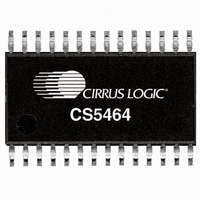CS5464-ISZ Cirrus Logic Inc, CS5464-ISZ Datasheet - Page 40

CS5464-ISZ
Manufacturer Part Number
CS5464-ISZ
Description
IC ENERGY METERING 1PHASE 28SSOP
Manufacturer
Cirrus Logic Inc
Datasheet
1.CS5464-ISZ.pdf
(46 pages)
Specifications of CS5464-ISZ
Package / Case
28-SSOP
Input Impedance
30 KOhm
Measurement Error
0.1%
Voltage - I/o High
0.8V
Voltage - I/o Low
0.2V
Current - Supply
3.5mA
Voltage - Supply
4.75 V ~ 5.25 V
Operating Temperature
-40°C ~ 85°C
Mounting Type
Surface Mount
Meter Type
Single Phase
Output Voltage Range
2.4 V to 2.6 V
Input Voltage Range
2.4 V to 2.6 V
Input Current
100 nA
Power Dissipation
500 mW
Operating Temperature Range
- 40 C to + 85 C
Mounting Style
SMD/SMT
Input Voltage
5V
No. Of Outputs
3
Power Dissipation Pd
500mW
Supply Voltage Range
3.3V To 5V
No. Of Pins
28
Filter Terminals
SMD
Rohs Compliant
Yes
Lead Free Status / RoHS Status
Lead free / RoHS Compliant
For Use With
598-1554 - BOARD EVAL FOR CS5464 ADC
Lead Free Status / Rohs Status
Lead free / RoHS Compliant
Other names
598-1194-5
Available stocks
Company
Part Number
Manufacturer
Quantity
Price
Part Number:
CS5464-ISZ
Manufacturer:
CIRRUS
Quantity:
20 000
9.1.2 Gain Calibration
During gain calibration, a full-scale reference signal
must be applied to the meter or optionally, scaled to the
VIN ± , IIN1 ± (IIN2 ±) pins of the CS5464. A DC reference
must be used for DC gain calibration. Either an AC or
DC reference can be used for RMS AC calibrations. If
DC is used, the associated high-pass filter (HPF) must
be off.
Using a reference that is too large or too small can
cause an over-range condition during calibration. Either
condition can set Status register bits I1OR (I2OR)
V1OR (V2OR) for DC and I1ROR (I2ROR) V1ROR
(V2ROR) for AC calibration.
Full scale (FS) for the voltage input is ±250mV peak and
for the current inputs is ±250mV or ±50mV peak de-
pending on selected gain range. The normal peak volt-
age applied to these pins should not exceed these
levels during calibration or normal operation.
The range of the gain registers limits the gain calibration
range and subsequently the range of the reference level
that can be applied. The reference should not exceed
FS or be lower than FS/4.
9.1.2.1 AC Gain Calibration
Full scale for AC RMS gain calibrations is 60% of the in-
put’s full-scale range, which is either 250mV or 50mV
depending on the gain range selected. That’s 150mV or
30mV, again depending on range. So the normal refer-
ence input level should be either 150 or 30 mV
or DC.
Prior to executing an AC Gain Calibration command,
gain registers for any channel to be calibrated should be
set to 1.0 if the reference level mentioned above is
used, or to that level divided by the actual reference lev-
el used.
40
R eference
Figure 12
Signal
CM + -
Figure 12. System Calibration of Gain.
+
-
shows the basic setup for gain calibration.
External
Connections
IN+
IN-
+
-
XG AIN
RMS
+
-
, AC
During AC gain calibration the RMS level of the applied
reference is measured with the preset gain, then divided
into 0.6 and the quotient stored back into the corre-
sponding gain register.
9.1.2.2 DC Gain Calibration
With a DC reference applied, the DC Gain Calibration
command measures and averages DC values read on
the specified voltage or current channels and stores the
reciprocal result in the associated gain registers, con-
verting measured voltage into needed gain. Subse-
quent conversions will use the new gain value.
9.1.3 Calibration Order
1. DC offset.
2. DC or AC gain.
3. AC offset (if needed).
If both AC gain and offset calibrations were performed,
it is possible to repeat both to obtain additional accuracy
as AC gain and offset may interact.
9.1.4 Temperature Sensor Calibration
Temperature sensor calibration involves the adjustment
of two parameters -
be known in order to calibrate the temperature sensor.
See
21 for an explanation of
culate T
9.1.4.1 Temperature Offset Calibration
Offset calibration can be done at any temperature, but
should be done mid-scale if any gain error exists.
Subtract the measured T register temperature from the
actual temperature to determine the offset error. Multi-
ply this error by
V
9.1.4.2 Temperature Gain Calibration
Two temperature points far enough apart to give rea-
sonable accuracy, for example 25°C and 85°C, are re-
quired to calibrate temperature gain.
Divide the actual temperature difference by the mea-
sured ( T register) difference for the two temperatures.
This gives a gain correction factor. Update the T
register by multiplying it’s value by this correction factor.
Update
rection factor. It will be needed for subsequent offset
calibrations.
BE
0 value. Recalculate T
Section 6.13 Temperature Measurement
GAIN
∆
V
BE
and T
by dividing its old value by the gain cor-
∆
V
OFF
BE
∆
V
and add it to V
BE
register values from them.
∆
V
and V
OFF
BE
and V
using this new value .
BE
0. These values must
BE
BE
0 and how to cal-
0 to yield a new
CS5464
DS682F1
on page
GAIN


















